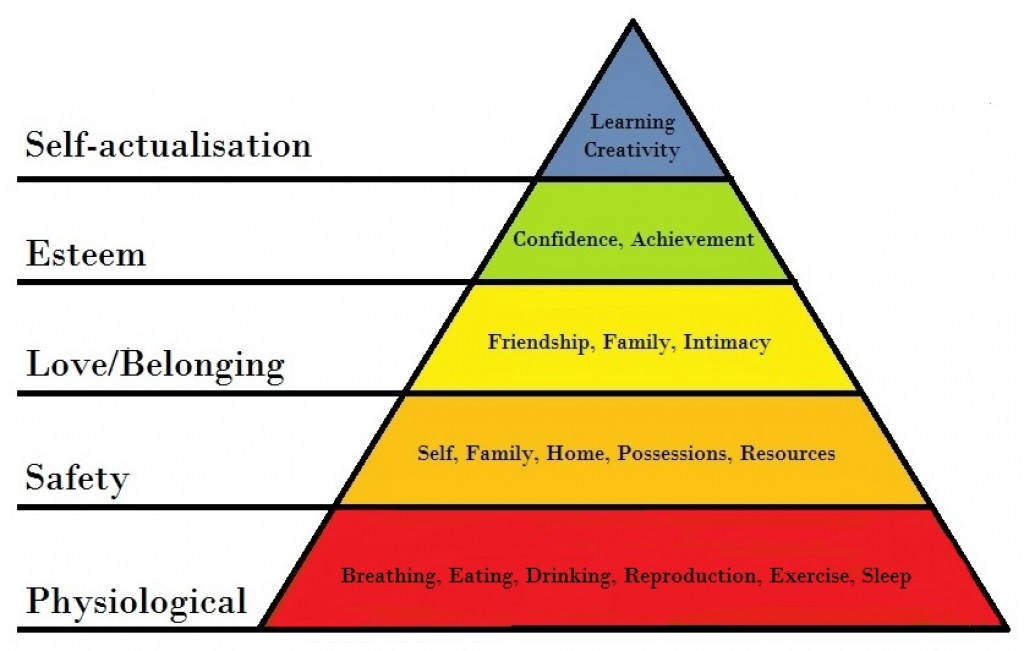Get an awesome recall. Join my 30 day, step by step program now...
The role of “needs” in canine rehabilitation training
Getting to the heart of the problem means understanding where the problem has come from. Maslow’s hierarchy of needs describes our needs and the order in which we prioritise and value them. I’ve adapted it slightly for dogs, but the principle is the same. Here’s how prioritising “needs” can help with your canine rehabilitation training.
Starting at the bottom of the pyramid; the most essential needs are listed first. The more vital the need, the more likely you are to see emotional or behavioural issues occurring when the need isn’t fully met.
As we move up the pyramid a dogs needs become less and less urgent. A dog that hasn’t been fed for a day will be far more likely to display behavioural changes when compared to a dog that hasn’t learned a new trick in the same amount of time.
Most behaviour problems come from an unfulfilled need in the bottom two sections of the pyramid.

Physiological needs
At the very bottom of the pyramid are the most essential needs of all. A dog simply cannot survive without these needs being met. Food, water and air are obviously extremely important. But also in this section, and therefore equally as important, are exercise, reproduction and sleep!
An imbalance of any of these needs could lead to unpredictable behaviour, poor recall, pulling, humping, house soiling, hyperactive and antisocial behaviours, barking, destructive behaviour, jumping up and mouthing.
How can I help you with your dogs behaviour training?
Private Dog Behaviour Consultations are currently available online and in-person in Dundee and the surrounding area. If you are looking for help solving your dogs behaviour and training problems, please get in touch!
Safety needs
Next up are the dogs safety needs. These include the territory, family, and resources. Any concerns related to safety can lead to problem behaviours such as barking, possessive behaviour, poor general obedience, scent marking, aggression to strangers, starving himself, demanding behaviours, jumping up, chewing, begging and separation anxiety.
Essential needs first
So, before we can start on a rehabilitation plan we need to address these bottom layers first. There’s no point trying to teach a disobedient dogs lots of tricks (self actualisation need), while he is worrying about how to keep his pack safe tonight (safety need). That makes no sense at all.
Ever wondered how it is that a dog can know a perfect recall, but still chase scents in the park? This is why. Dog training sits at the top of the pyramid. A dog that has never been taught a recall but is content will not run off. These are the dogs everyone is jealous of as they had no training but just toddle about.
If you’ve ever worked on a behaviour and the training stopped working after a week, or the problem went away, but a new one started in it’s place. It’s usually because the bottom two sections of the pyramid have not been settled.
Where did it all go wrong?
Every dog is so different, that very often this happens even though you are doing an amazing job. A dog that is overly anxious will worry far more than another dog would. They will need extra reassurance when answering the front door, or when meeting other dogs, than your average dog. An over thinker will hesitate more than normal, and worry when you are away.
Of course, some dogs have a less than perfect start in life. Rescue dogs might have genuine reasons to worry about their security and home, for example! And ex-street dogs might have underlying issues concerning food and possessions. These dogs will need extra reassurance at the bottom of the pyramid to prevent an unstable foundation.
Solving the bottom two layers
The first step of your canine rehabilitation training plan should focus on these bottom two layers. When I assess your dog I’ll be considering any area he might need extra help or reassurance and I’ll show you ways to satisfy these needs. The better we do here, the more motivated your dog will be to change when we start working on the specific behaviours you are concerned with. In fact, in some cases, the behaviour that is attached to the need can almost solve itself. Working from the bottom up, it really can be that powerful!
How can I help you with your dogs behaviour training?
Private Dog Behaviour Consultations are currently available online and in-person in Dundee and the surrounding area. If you are looking for help solving your dogs behaviour and training problems, please get in touch!
How can I help you with your dogs behaviour training?
Private Dog Behaviour Consultations are currently available online and in-person in Dundee and the surrounding area. If you are looking for help solving your dogs behaviour and training problems, please get in touch!


